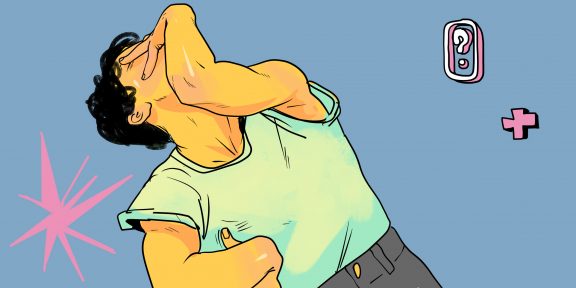Migraine is a special type of primary headache associated with increased sensitivity of the trigeminal nerve system. Various triggers lead to local expansion of the microvessels of the brain membrane and its irritation by pain mediators. The latter can last for hours or even days, but does not signal danger.
To get rid of painful sensations , you need to act differently than with ordinary pain. However, first it is important to make sure that it is a migraine.
When you need to call an ambulance urgently
Headache sometimes indicates a stroke , cerebral hemorrhage, meningitis and other dangerous conditions. Their symptoms may be:
- sudden and very severe pain;
- pain that intensifies over several days, as well as with every sudden movement, coughing, or simply straining the muscles;
- pain that is accompanied by high fever, rash, dizziness, repeated vomiting, double vision, numbness of the neck muscles;
- loss of consciousness;
- numbness or weakness of one limb or side of the face;
- blurred vision;
- slurred, severely distorted speech;
- a strong increase in pressure (more than 180/120 mm Hg);
- pain that occurs within 7 days after a head injury;
- pain that has changed for the first time in many years or appeared after age 50.
In such cases, emergency medical care is required. Only if you are sure that you are dealing with a benign headache, including migraine, can you try to alleviate the condition at home.
How to Relieve Migraine Headaches
Here are the methods approved by doctors.
1. Take a painkiller at the first sign of an approaching migraine
For mild migraines without nausea and vomiting, over-the-counter medications based on ibuprofen, paracetamol, naproxen or acetylsalicylic acid are recommended first . But there is an important nuance: the pill should be taken as early as possible, at the first signs of pain, but at the end of the aura .
In this case, the medicine can stop neurological pain at the very start, when it is not yet too strong. If you take a painkiller when a migraine attack is already in full swing, the medicine will not work very quickly, because at this time intestinal motility is slowed down , and hence the absorption of the drug.
When taking pills, keep a few rules in mind.
- Follow the instructions strictly and do not exceed the dosage of the product.
- Consult your physician to select an effective and safe medication. For example, acetylsalicylic acid is not recommended for children under 16, as well as adults with stomach ulcers or liver and kidney diseases.
- Don't take painkillers too often: no more than 15 days a month for simple painkillers and caffeine, and no more than 10 days a month for combination medications, triptans, and ergotamine. Otherwise, the pills may provoke another type of ailment - headache associated with excessive use of medications.
If over-the-counter remedies don't help, see your doctor. The doctor will prescribe you more powerful drugs: based on triptans, ergotamine, opioids. Please note that these medications have serious side effects and should only be prescribed by a qualified healthcare professional.
2. Have a snack
Lack of food causes your blood sugar to drop . Sometimes this is what triggers a headache. If it's not too severe, try eating a cracker, banana, or other high-carb food - there's a chance it will help stop or ease the migraine.
3. Drink some water
Lack of fluid can also trigger migraines. Therefore, take at least a few sips of water, compote, fruit drink or juice.
4. Drink coffee
Or another drink containing caffeine . This substance can relieve the pain of migraines in the early stages and enhance the analgesic effect of tablets based on paracetamol and acetylsalicylic acid. Like medicine, you need to drink coffee at the beginning of an attack - then the effect will be stronger.
Remember that it is important not to abuse caffeine, because then a headache may appear when you give it up. And if you drink coffee or tea in the evening, your sleep may be ruined, which is also harmful for migraines.
5. Relax in a quiet, dark place
Migraines often occur due to excessive sensitivity to light and sounds. To make the attack stop faster, you need to remove these irritants.
Go to your bedroom or other secluded room, close the door, close the windows with thick curtains, turn off the lights and try to sleep.
6. Apply a cold compress to your forehead
This could be a napkin soaked in cool water or an ice pack wrapped in a thin cloth.
Exposure to cold slightly numbs the pain and slightly softens the pain.
7. Apply a warm compress to your head or neck
For example, a heating pad or gauze soaked in warm water. Such compresses help relieve muscle tension, which can increase headaches.
8. Give yourself a light massage
To reduce muscle tension, knead your neck with your fingers and apply pressure to the scalp.
9. Try to relax
This is necessary to calm the overexcited brain. Take a few long deep breaths in and out, meditate , relax all your muscles as much as possible - perhaps one of these techniques will work and you will feel better.


0 Comments